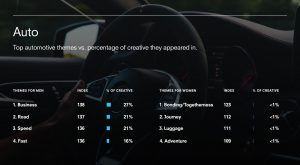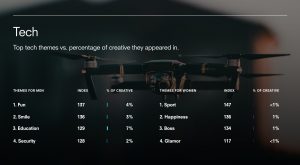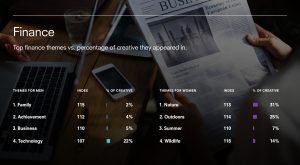International Women’s Day presents a big question for brands. It’s not how to leverage the day for some great PR, or even how to use it as a moment in time to celebrate female talent. The real question is why the themes raised by the day aren’t a focus year-round?
If we want to achieve gender parity when it comes to careers, opportunity, and representation, we need a better level of understanding of what needs to change. More importantly, we need to demonstrate our commitment through ongoing action. Today, we’re calling on brands to do just that.
At Quantcast, we have a unique view of what we call the behavioural graph. This live data stream, based on more than 100 million mobile and web destinations, gives us a real-time insight into how the world’s online audience interacts with brands. As a result we can see how well different sectors are doing at engaging different audiences, and how they’re doing it.
Ahead of this year’s International Women’s Day, we used AI technology to analyse the creative themes in more than 4,000 ads across 1,300 campaigns in the auto, tech and finance sectors. Our team looked at two aspects of online advertising aimed at men and women in the UK: which themes in ads were most effective at engaging each audience, and then how frequently these themes appeared in the ads themselves. The results were startling.
Auto brands trailing other sectors in engaging women
The automotive sector showed the biggest gap between the themes that were most engaging to women and how frequently they appeared in ads. In some cases, the most impactful themes for a female audience appear in less than one percent of creatives. That’s a huge potential missed growth opportunity for these brands, but also a damning indication of how well they seem to understand their audience.

Tech sector fares a little better, but not much
Despite all the smart new technology that brands in this sector offer consumers, it seems they’re not always relying on the latest technology to inform their creative strategies. What’s also surprising here is how infrequently the most impactful themes for men appear. Could a better link between the compelling nature of a theme and its appearance in creative unlock new growth opportunities for tech companies?

Finance is on the money (sort of)
The financial sector appears to be doing the best job of tailoring its creative to engage women, but it’s a low bar.

No excuse for not understanding your audience
It would have been impossible – or at least incredibly time consuming – to gain these types of insights even a few years ago. For brands looking to grow in the 21st Century, AI and the scale of internet advertising gives us new ways to understand their audiences, and how to effectively engage them. There’s little excuse today for not making sure that equality goes beyond rhetoric and lip-service, and is reflected in how brands act when it comes to promoting themselves. Those that don’t #pressforprogress are sure to be left behind.
—
About the data
Quantcast used AI-driven visual analysis technology to identify the key themes in 4,000 creatives across 1,300 campaigns that ran between November 2017 and February 2018 in the auto, tech and finance sectors. Quantcast then merged the results with its campaign data to identify the themes which were most effective at engaging men and women across each sector.